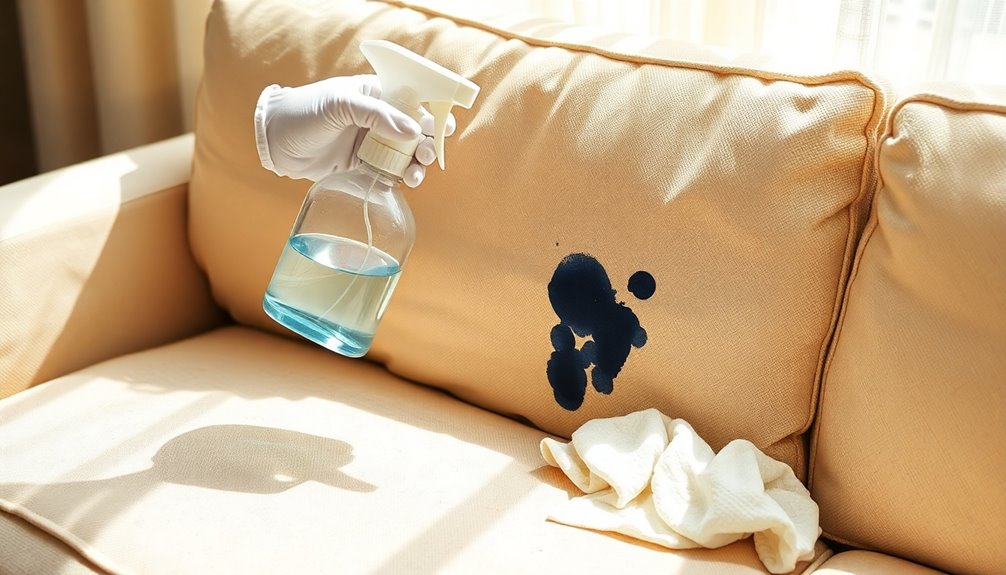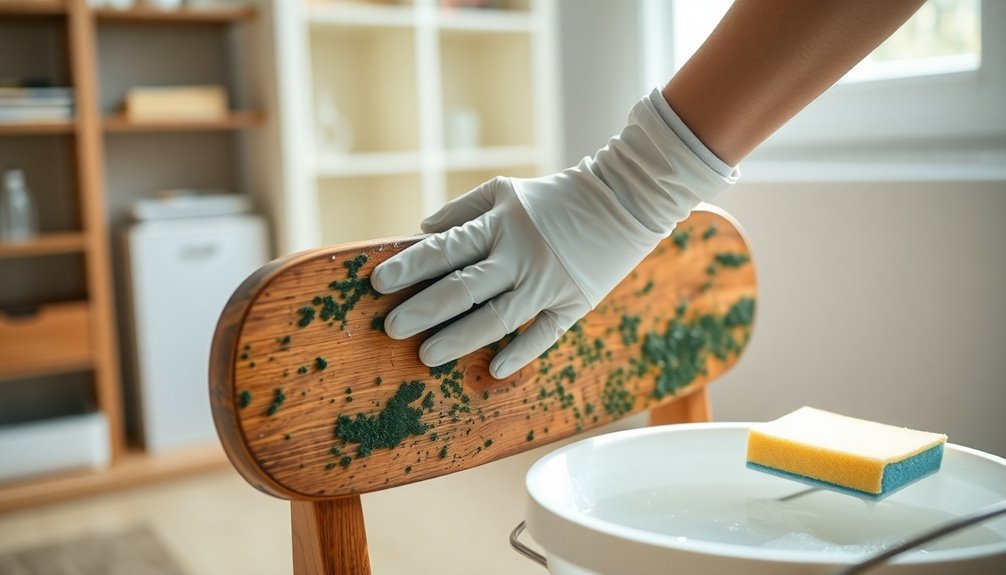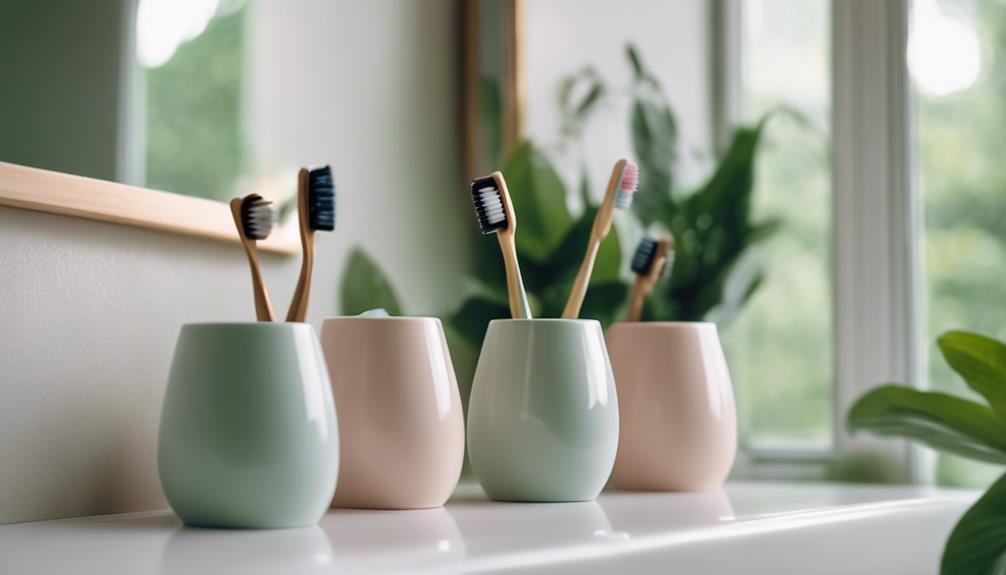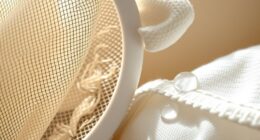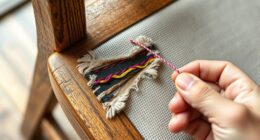To get ink out of your sofa, act quickly. First, gently blot the stain with a clean cloth to absorb excess ink—don't rub, as that spreads it further. For water-based inks, mix dish soap and water; for permanent ink, use rubbing alcohol on a cloth and dab the area. Always test solutions on an inconspicuous spot first. After treatment, rinse the area with clean water, and dry it gently to avoid damage. Regular maintenance can help prevent future stains. Keep going to discover more effective cleaning methods and tips tailored to your sofa's fabric!
Key Takeaways
- Blot the ink stain immediately with a clean cloth to absorb excess ink and prevent spreading.
- Identify the fabric cleaning code; use water-based solutions for "W" code fabrics or solvent-based cleaners for "S" code fabrics.
- Apply rubbing alcohol or a dish soap and water mixture gently to the stain using a dabbing motion, avoiding scrubbing.
- Rinse the area with clean water after treatment to remove any residue, and dry with a towel to prevent water damage.
- Consider using a stain-resistant treatment on upholstery to protect against future stains and simplify cleaning.
Introduction
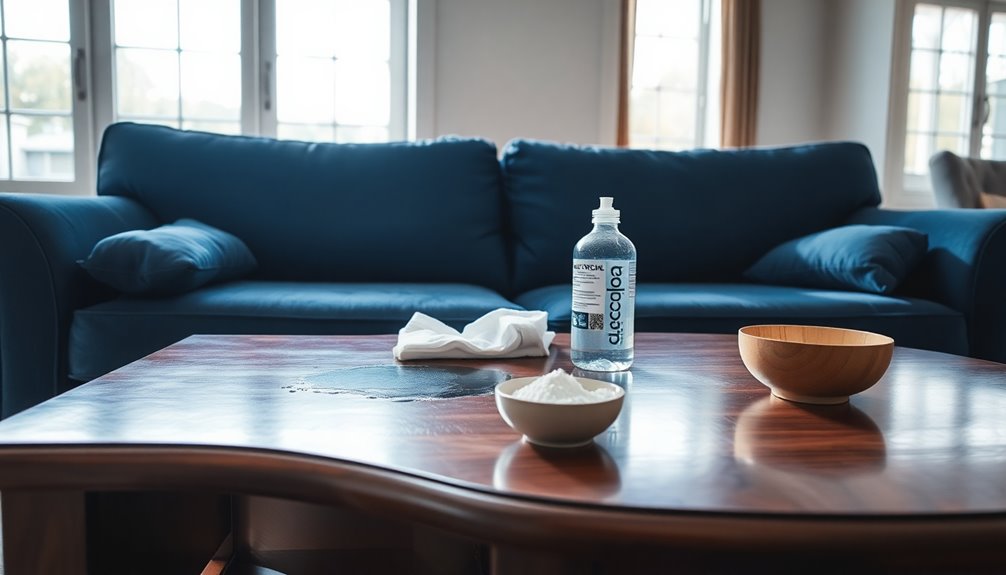
When ink stains hit your sofa, knowing how to tackle them can save your furniture. You'll want to consider routine spot cleaning, use material-specific techniques, and address those pesky ink and wine stains quickly. Let's explore the best methods to keep your sofa looking fresh and clean.
Routine Spot Cleaning
Ink stains on your sofa can be a real eyesore, but routine spot cleaning can help you tackle them effectively. The key to successful ink stain removal is acting quickly. The sooner you address the stain, the better your chances of getting rid of it without damaging your sofa fabric. Always check the cleaning code on your sofa before diving in; it'll guide you on which cleaning solutions are safe to use.
Gather your cleaning supplies, including rubbing alcohol, white vinegar, dish soap, and clean cloths. Begin by gently blotting the ink stain with a clean cloth to absorb as much ink as possible. Avoid rubbing, as this can push the ink deeper into the fabric. Instead, apply a small amount of your chosen cleaning solution to a clean cloth and continue to blot the area until the stain lifts. Remember, it's essential to test any cleaning solution on an inconspicuous area first to ensure it won't damage or discolor your sofa fabric. By incorporating these routine cleaning practices, you can keep your sofa looking fresh and free of unsightly ink stains.
Material-Specific Cleaning Techniques
Choosing the right cleaning technique for your sofa's fabric is crucial for effectively removing ink stains without causing damage. Different fabrics require distinct methods. If your sofa has a "W" code fabric, you can safely use water-based solutions. For these, a mixture of dish soap and vinegar works well to lift water-based ink stains, ensuring you don't harm the delicate material.
However, if your sofa has an "S" code fabric, you'll need to turn to solvent-based cleaners like rubbing alcohol. This powerful solution penetrates deep into the fabric to dissolve ink stains from pens or markers. Always test any cleaning solution on an inconspicuous area first, as this will help you confirm that it won't cause discoloration or damage.
For leather sofas, be cautious. Traditional cleaning methods can harm the leather's surface, so it's best to use specialized products designed for leather cleaning. By being mindful of your specific sofa fabric and using the right techniques, you can effectively remove ink stains while preserving the integrity of your furniture.
Treating Ink and Wine Stains
Stains can be a homeowner's worst nightmare, especially when they come from ink or wine. Quick action is crucial to prevent ink and wine stains from setting into your sofa. For dry ink stains, you can use the rubbing alcohol method. Start by testing any cleaning solution on an inconspicuous area to ensure it won't damage the fabric. If it's safe, apply a small amount of rubbing alcohol to a clean cloth or paper towel and gently blot the stain. Continue blotting until the stain starts to lift.
For wine stains, a vinegar solution can work wonders. Mix equal parts of dish soap, white vinegar, and water. Apply this mixture onto the stain using a clean cloth, and again, blot until the stain is removed. Regardless of the stain type, remember that patience is key. Blotting gently is essential to avoid spreading the stain further. With these methods, you can effectively tackle ink and wine stains, keeping your sofa looking fresh and prolonging its life. Regular maintenance and prompt treatment will save you from the stress of stubborn stains in the future.
Stain-Resistant Fabric Treatments
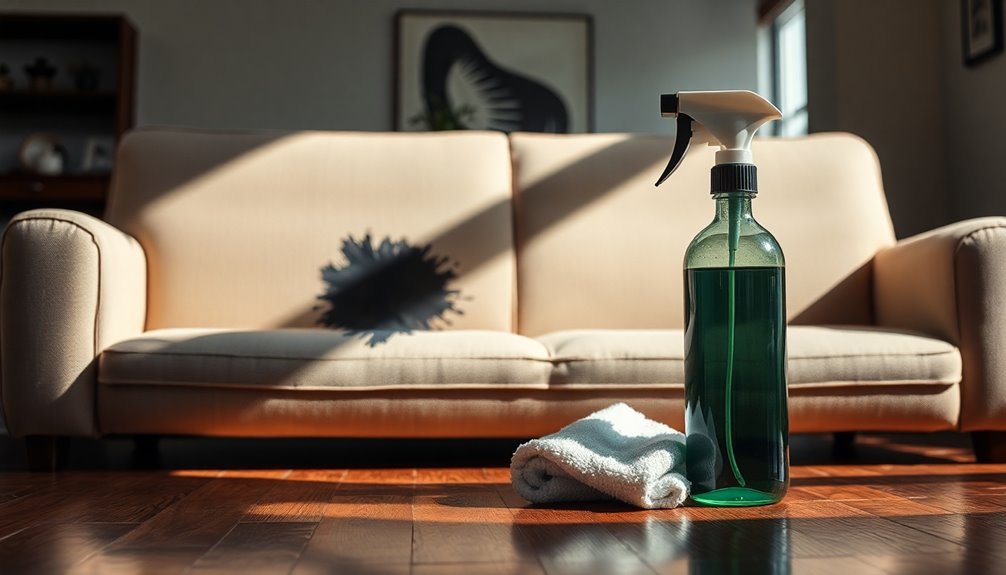
When it comes to keeping your sofa looking great, stain-resistant fabric treatments are essential. These treatments not only protect against spills but also minimize friction, helping to prevent scratches and prolong the life of your upholstery. By investing in a sofa with these features, you'll make maintenance much simpler and enhance the overall durability of your furniture.
Scratch-Resistant Materials
Often, homeowners find themselves dealing with unexpected spills on their sofas, making the choice of scratch-resistant materials crucial. When selecting upholstery fabrics, you should consider options that incorporate advanced fiber technologies. These materials create a protective barrier against stains and damage while ensuring comfort and aesthetics.
Stain-resistant fabric treatments, such as those featuring Teflon or Scotchgard, can significantly reduce the absorption of liquids and ink. This makes cleaning up ink stains easier, allowing you to act quickly before they set in. Choosing upholstery made from synthetic fibers like polyester or nylon often results in greater durability and scratch resistance compared to natural fabrics.
Regular maintenance and the application of fabric protectors can further prolong the life of your scratch-resistant materials. By doing so, you'll enable easy wipe-downs and prevent deeper stains from forming. Investing in these materials not only enhances the longevity of your sofa but also simplifies your cleaning routine. With the right choices, you can enjoy a stylish and resilient sofa that stands up to everyday wear and tear while making ink stain cleanup a breeze. Additionally, utilizing energy-efficient technology can also contribute to creating a more sustainable home environment.
Protective Fabric for Spills
Regularly investing in stain-resistant fabric treatments can make a significant difference in how well your sofa withstands spills. These treatments create a protective barrier that helps repel both water-based and oil-based stains, making it easier to wipe away potential messes before they penetrate the fabric. Whether it's ink from a pen or a splash of sauce, having this protection reduces the likelihood of permanent damage.
To maintain the effectiveness of these stain-resistant treatments, you should consider regular application, especially after professional cleaning. This ensures that your sofa continues to look great and resist dirt and grime buildup. Many of these treatments are non-toxic, making them safe for various fabric types, including cotton and polyester blends.
Incorporating stain-resistant fabric treatments into your furniture care routine will help extend the life of your upholstery, giving you peace of mind when it comes to spills. By taking these proactive steps, you'll significantly reduce the stress and hassle of dealing with unexpected messes, allowing you to enjoy your sofa without worry.
Minimize Friction on Fabric
To effectively minimize friction on fabric while tackling ink stains, it's crucial to use gentle blotting techniques instead of rubbing. Rubbing can spread the ink and damage the fabric fibers, making the situation worse. Instead, you should blot the ink stain with a clean cloth or paper towel, applying light pressure to absorb as much ink as possible.
Employing stain-resistant fabric treatments is another great way to create a protective barrier against spills. When you regularly apply protective sprays containing silicone or fluoropolymer, you help repel liquids, preventing ink from absorbing into the fabric. However, always remember to test any stain-resistant treatment on an inconspicuous area first to ensure it's compatible and won't cause discoloration.
Maintaining the integrity of stain-resistant fabrics is essential. Regularly clean them with appropriate cleaning solutions to ensure the protective barrier remains effective. By taking these steps, you'll not only tackle current ink stains more effectively but also prevent future stains from becoming a problem. With the right techniques and treatments, your sofa can stay looking its best, no matter what spills come your way.
Upholstery Fabric Care Tips
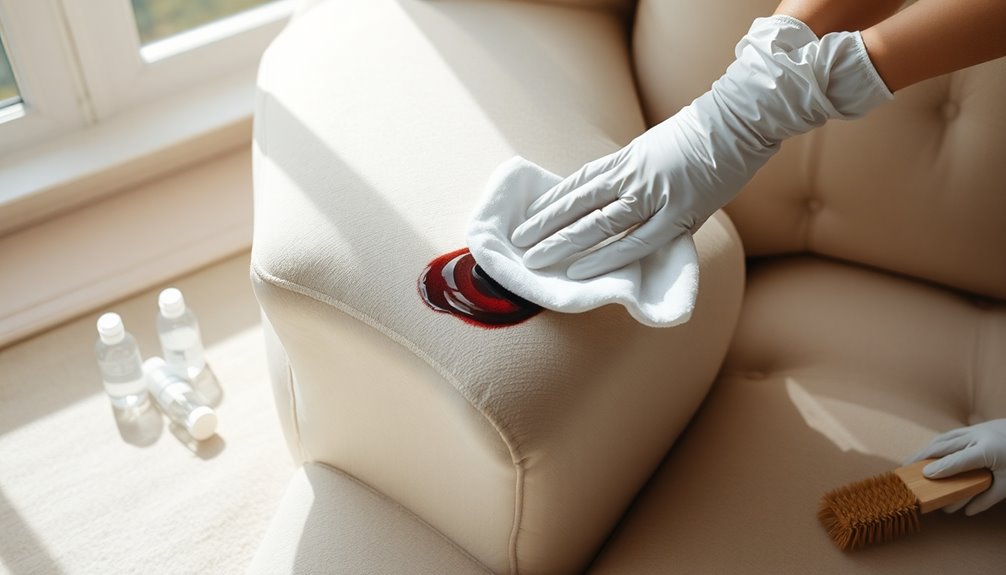
Taking care of your upholstery is essential to keep it looking great and lasting longer. You'll want to pay attention to fabric integrity, use proper leather conditioning techniques, and follow cozy fabric maintenance tips. By staying proactive, you can enjoy your furniture for years to come. Additionally, incorporating natural materials like wood can enhance the overall aesthetic of your space while providing durability.
Fabric Integrity Concerns
Maintaining your sofa’s fabric integrity is crucial for keeping it looking fresh and inviting. Before you attempt any stain removal, always check the cleaning code of your upholstery. This ensures the methods you choose won’t damage the fabric. When tackling stains, use gentle soap and a stain remover that’s safe for your fabric type. Remember to blot the area instead of rubbing it; this prevents fraying and pilling. Additionally, it’s essential to understand how to strip furniture effectively if you plan to refresh or change the color of your sofa’s fabric. Always start by testing any cleaning or stripping solution on a hidden area to ensure it doesn’t adversely affect the material. Regular maintenance, such as vacuuming and promptly addressing spills, will also contribute to a longer lifespan for your upholstery, keeping it looking its best for years to come.
Regularly vacuuming your sofa and performing maintenance cleaning can significantly reduce the chances of stains setting in. If you're trying a new cleaning solution, test it on a hidden area first to check for any potential discoloration or damage. This precaution helps protect your upholstery from unexpected results. Additionally, keeping an eye out for signs of bed bug infestations can help you maintain your sofa's overall condition.
After cleaning, consider applying fabric protectants. They create a barrier against future stains while preserving the fabric's original texture and appearance. By following these tips, you can keep your sofa looking its best and extend its lifespan. Prioritizing fabric integrity means your sofa will remain a welcoming centerpiece in your living space for years to come.
Leather Conditioning Techniques
Caring for your upholstery goes beyond just fabric; leather also requires attention to stay in top shape. Regular maintenance is key, so aim to apply a high-quality leather conditioner every 6-12 months. This helps maintain the softness of the leather and prevents cracking, which can lead to irreversible damage.
Before applying the conditioner, take a soft, damp cloth and wipe down the leather surfaces. This cleaning step is crucial as it removes dust and dirt that can hinder the absorption of the conditioner. When trying a new leather care product, always test it on an inconspicuous area first. This ensures compatibility with your specific leather type and prevents any adverse reactions.
Avoid using harsh chemicals or abrasive materials during cleaning, as they can cause permanent damage to the leather's finish. Lastly, be mindful of where you store your leather furniture. Keep it away from direct sunlight and heat sources to prevent fading and drying out, which can compromise its integrity. By following these leather conditioning techniques, you'll keep your upholstery looking great for years to come. Additionally, regular cleaning with water-based solutions can help maintain the leather's appearance without damaging its surface.
Cozy Fabric Maintenance Tips
To keep your upholstery looking its best, regular maintenance is essential. Start by regularly checking the cleaning codes on your sofa. This helps you determine the appropriate cleaning methods to avoid fabric damage. Use a vacuum cleaner with an upholstery attachment to remove dust and debris, maintaining a clean and fresh appearance.
For spills or stains, it's crucial to act quickly. Blot the stain with a clean white cloth to absorb the liquid and prevent it from setting into the fabric. When it comes to removing ink stains, ensure you don't rub, as this can spread the ink further. Instead, gently blot until the stain lifts.
Consider using fabric protectants to create a barrier against future stains and spills, enhancing the longevity of your upholstery. Additionally, periodically rotate cushions and pillows to ensure even wear and maintain the shape and comfort of your sofa. Lastly, avoid letting any stain dry; the sooner you treat it, the better your chances of complete removal. By following these maintenance tips, you'll keep your upholstery looking cozy and inviting for years to come. Regularly checking and cleaning upholstery can also improve indoor air quality, similar to how air purifiers maintain efficiency.
Fabric Treatment Enhancements
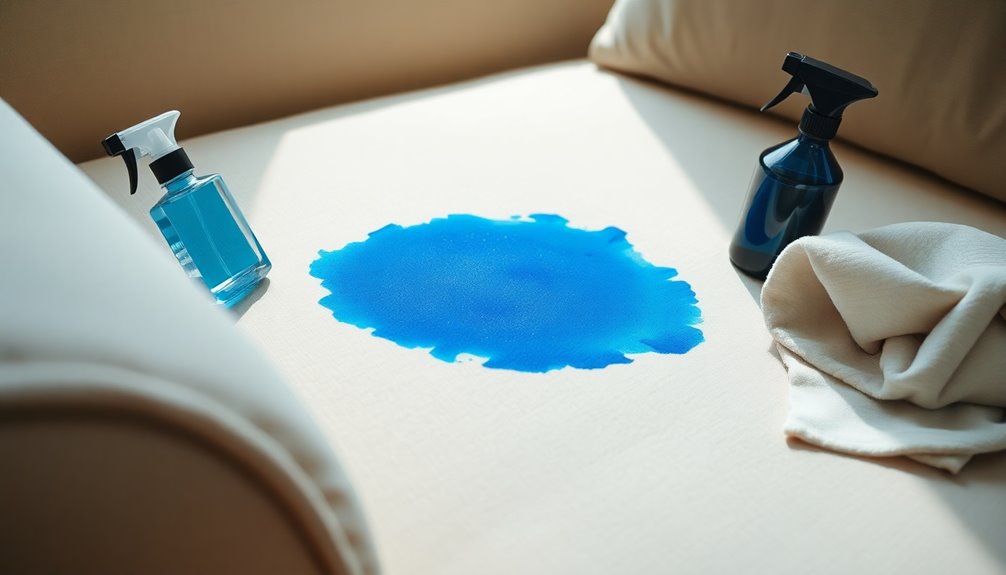
Enhancing the treatment of your fabric sofa can significantly boost its longevity and appearance. Start by always checking the manufacturer's care instructions before applying any cleaning solutions. This ensures you use the right methods and products suited for your specific fabric. When tackling stains, like ink, consider using rubbing alcohol on a clean cloth, but test it on an inconspicuous area first to avoid discoloration.
After you've removed the stain, it's essential to clean before drying. Use a gentle soap mixed with water to wipe the area, then blot with a dry cloth. Incorporating a gentle, pH-balanced upholstery cleaner into your routine can help maintain the fabric's resilience and enhance its overall look over time.
Once your sofa looks great, consider applying fabric protectors. These create a barrier against future stains and spills, making clean-up much easier. Regular maintenance, including vacuuming and prompt attention to stains, will also contribute to the sofa's longevity. By taking these simple steps, you'll keep your fabric sofa looking fresh and inviting for years to come.
Routine Maintenance for Upholstery
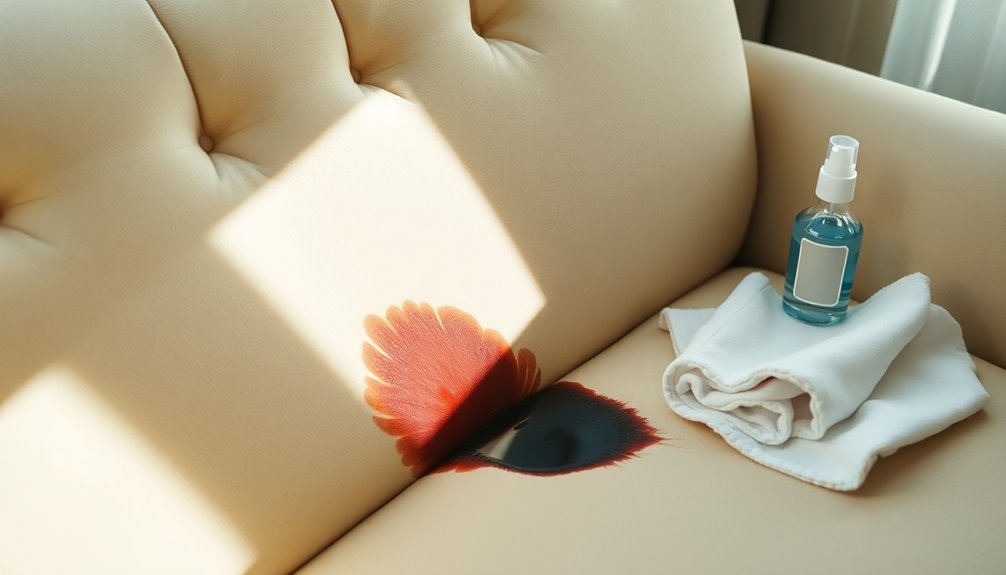
Maintaining your upholstery goes hand in hand with the treatments you've applied to protect it. To keep your furniture looking its best, you should regularly vacuum to remove dust and debris. This simple step helps prevent dirt buildup that can contribute to stains and discoloration. Aim to use fabric-safe upholstery cleaners at least once every six months to maintain appearance and ensure the integrity of the fabric.
When it comes to cushions and pillows, don't forget to rotate them periodically. This practice ensures even wear and prolongs the life of your upholstery. If you encounter spills and stains, act quickly! Blotting with a clean cloth can prevent them from setting into the fabric, making it easier to clean later.
Finally, be mindful of sun exposure. Keeping upholstery away from direct sunlight minimizes fading and deterioration over time. By implementing these routine maintenance tips, you can keep your upholstery looking fresh and inviting, ensuring it remains a beautiful centerpiece in your home. With a little effort, you'll enhance its longevity and maintain its appearance for years to come.
Conclusion
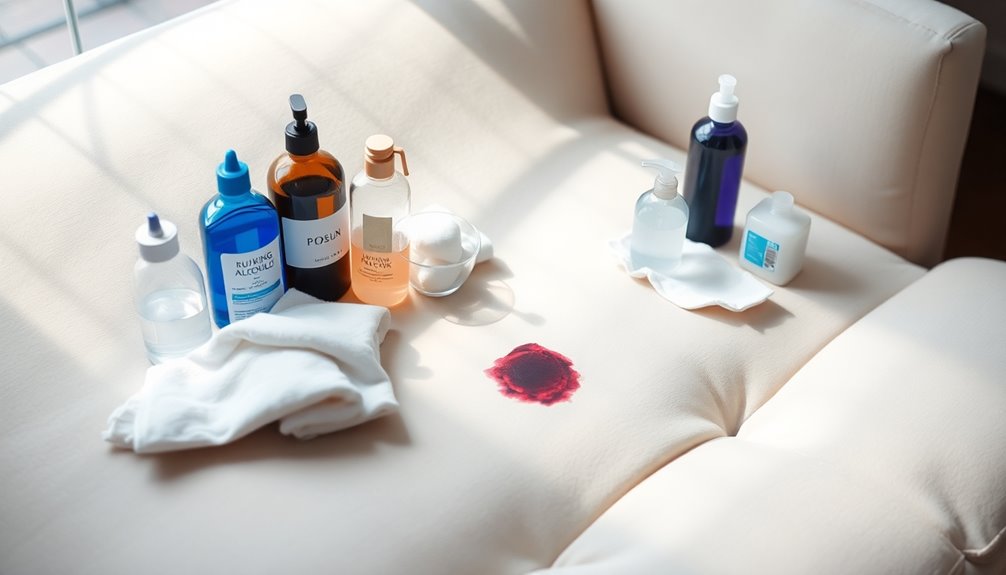
Successfully removing ink from your sofa can feel daunting, but with the right approach, you can tackle the stain effectively. The key is to act quickly; the sooner you address the ink stain, the better your chances of complete removal. Start by determining the type of ink involved—solvent-based inks respond well to rubbing alcohol, while water-based inks can be treated with a cleaning solution of dish soap and vinegar.
Before applying any cleaning solution, always test it on an inconspicuous area of the fabric to avoid discoloration or damage. When you're ready to treat the stain, use a dry cloth to gently blot the stain rather than rubbing it, which can spread the ink and push it deeper into the fabric.
If your home remedies don't yield results, don't hesitate to seek professional cleaning. Experts have access to specialized techniques and solutions that can tackle even the most stubborn ink stains. With these steps in mind, you're well-equipped to restore your sofa and keep it looking pristine. Remember, quick action and the right methods are your best allies in this cleaning challenge.
Frequently Asked Questions
How Do You Get Ink Out of a Fabric Sofa?
To tackle an ink stain, start by blotting it with a clean, dry cloth to absorb as much ink as possible. For water-based inks, mix one tablespoon of dish soap and vinegar with two cups of warm water. Apply this solution and blot until the stain lifts. For pen inks, use rubbing alcohol on a cloth, blotting from the edge inward. Always rinse the area with water, then let it air dry completely.
How Do You Remove Ballpoint Pen Ink From Furniture?
To remove ballpoint pen ink from furniture, start by blotting the stain with a clean cloth to soak up as much ink as possible. Next, apply a small amount of rubbing alcohol to another clean cloth and gently dab the stained area, moving from the outside in. If the stain's still there, try a mix of dish soap and white vinegar. Always test solutions on a hidden spot first to avoid damage.
What Removes Ink From Fabric?
To remove ink from fabric, you've got a few effective options. Rubbing alcohol works wonders on solvent-based inks, while a mix of liquid dish soap and white vinegar tackles water-based stains. For tougher marks, try non-acetone nail polish remover, but be sure to test it first on a hidden spot. Quick action is crucial; the sooner you treat the stain, the better your chances of getting it out completely.
How to Get a Ballpoint Pen Out of Fabric?
To get a ballpoint pen out of fabric, start by blotting the stain with a paper towel to absorb as much ink as you can. Don't rub, as that can spread the stain. Next, apply rubbing alcohol to a clean cloth and dab the ink, working from the edges inward. If the stain lingers, mix dish soap and white vinegar, then blot until the ink lifts. Always test solutions first to avoid damage.
